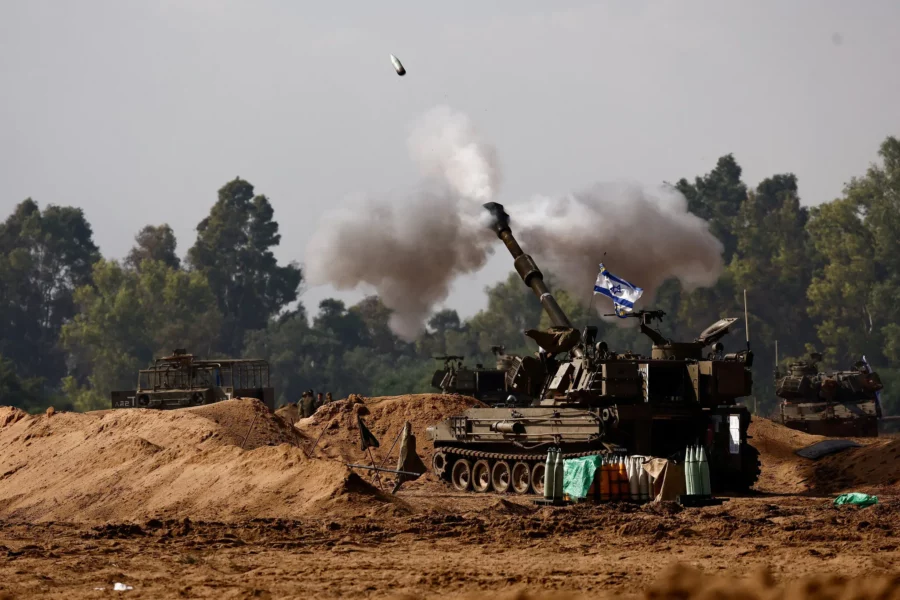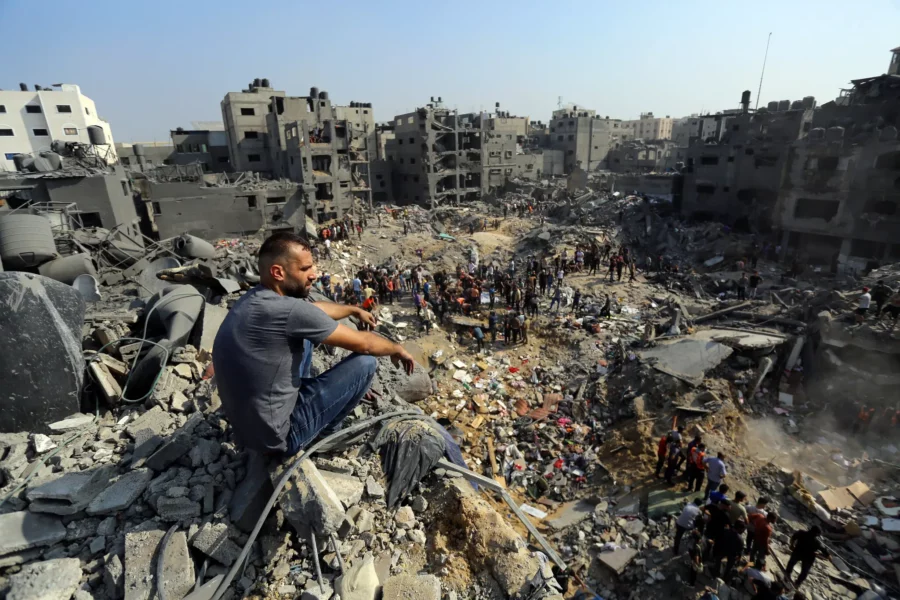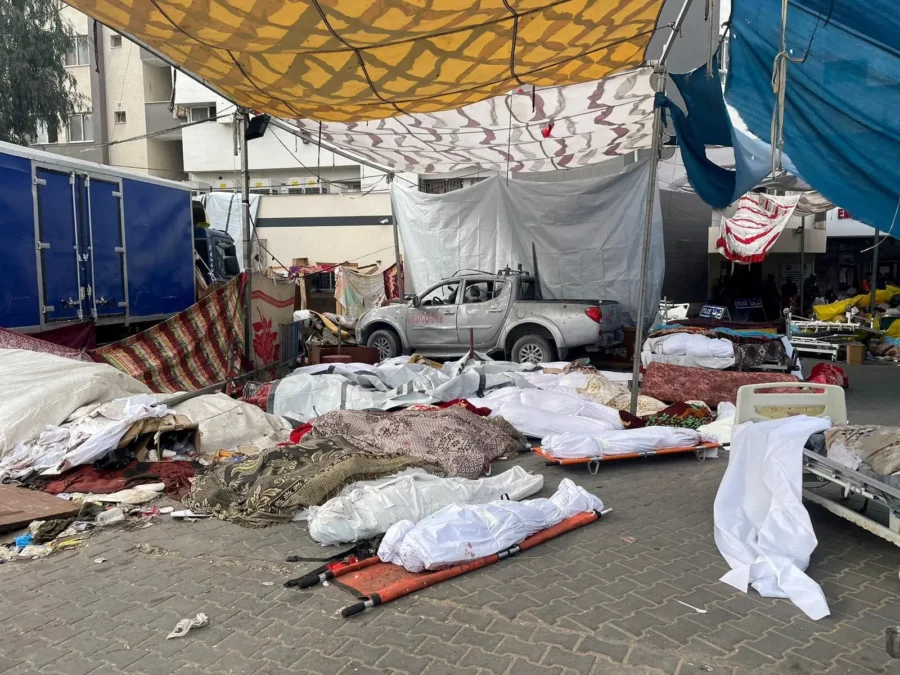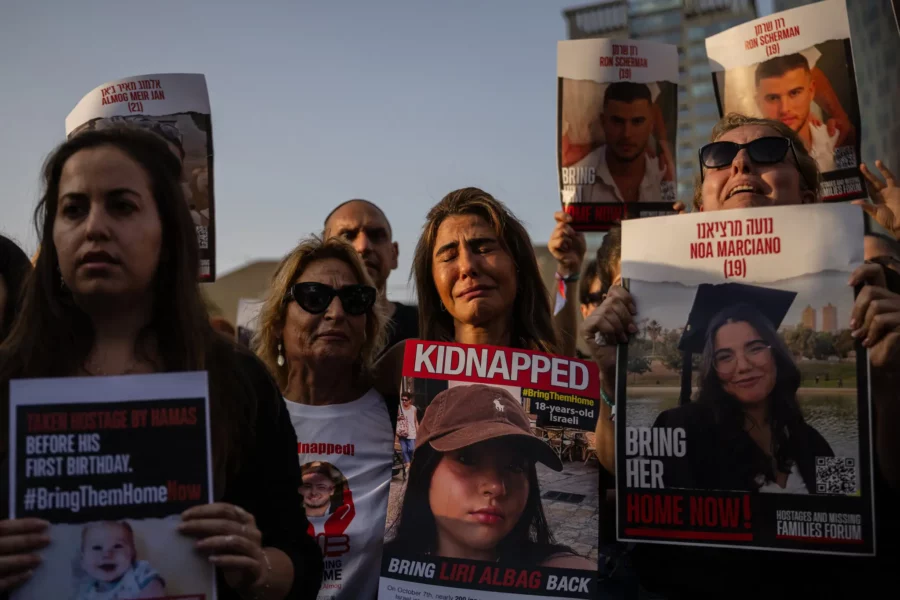

 da New York Times
da New York Times
Eric Schmitt, Ronen Bergman e Adam Goldman*
18 novembre 2023
L’attacco da parte dell’esercito israeliano all’ospedale Al-Shifa, il più grande complesso medico di Gaza, è centrale nella strategia militare alla base dell’invasione di terra: sradicare Hamas e liberare i circa 240 ostaggi presi durante l’attacco a sorpresa del 7 ottobre.
Questa strategia si è sviluppata nelle ultime tre settimane, quando più di 40.000 soldati israeliani hanno circondato Gaza City, dove secondo i funzionari israeliani si sono concentrati i comandanti di Hamas. I soldati hanno poi attaccato i combattenti e i bunker, prendendo di mira una vasta rete di tunnel che, secondo i funzionari israeliani, consente alle forze di Hamas di nascondersi e di condurre le operazioni militari.
Gli ufficiali israeliani hanno anche valutato che colpire così a fondo nel cuore di Gaza City avrebbe fatto pressione su Hamas per raggiungere un accordo sul rilascio degli ostaggi.
Israele accusa da tempo Hamas di usare i civili come scudi umani nella Striscia di Gaza, densamente popolata, e afferma che il gruppo terroristico ha posizionato strutture militari sotterranee vicino a case, scuole, moschee e ospedali in tutta Gaza. Al-Shifa è diventato il reperto A di questa narrazione, poiché l’esercito israeliano ha affermato che Hamas ha usato un vasto labirinto di tunnel sotto l’ospedale come base. Finora non è chiaro se la strategia israeliana stia funzionando.
I funzionari militari statunitensi hanno dichiarato che le loro controparti israeliane hanno detto loro di aspettarsi altre settimane di operazioni di sgombero nel nord prima che Israele prepari un’iniziativa separata nel sud di Gaza, ampliando l’offensiva.
Il portavoce capo dell’esercito israeliano, il contrammiraglio Daniel Hagari, ha dichiarato venerdì scorso che le truppe israeliane continueranno l’offensiva “in ogni luogo in cui si trova Hamas, ed è nel sud della Striscia”.
Anche se il ministro della Difesa israeliano, Yoav Gallant, ha dichiarato in un video di lunedì che Israele ha “accelerato le nostre attività contro i tunnel” e che i militanti di Hamas hanno perso il controllo nel nord e stanno fuggendo verso sud, gli analisti militari hanno detto che le dichiarazioni di Gallant sollevano molte domande.
Come sarà possibile eliminare Hamas se i suoi combattenti si mescolano al resto della popolazione mentre si dirigono verso sud? Per quanto tempo Israele, che ha perso circa 1.200 persone nelle atrocità del 7 ottobre, potrà sostenere le crescenti pressioni internazionali per un cessate il fuoco mentre le vittime civili a Gaza aumentano? E soprattutto, Al-Shifa era un obiettivo militare abbastanza importante da essere razziato?
Israele attribuisce la colpa delle morti civili – 11.000, secondo il ministero della Sanità di Gaza – in parte alla decisione di Hamas di nascondere le sue fortificazioni militari e i suoi centri di comando in quartieri residenziali e ospedali come Al-Shifa.

Ma i funzionari statunitensi hanno detto che la rapida decisione di Israele di lanciare operazioni di terra nell’enclave ha lasciato ai comandanti israeliani poco tempo per un’ampia pianificazione per ridurre i rischi per i civili e ha garantito un alto numero di vittime civili.
L’ospedale è diventato un particolare punto di infiammabilità. I militari devono ancora presentare pubblicamente le prove di un’estesa rete di tunnel e di un centro di comando sotto Al-Shifa, e Israele sta subendo crescenti pressioni internazionali per dimostrare che l’ospedale era un obiettivo militare critico.
Venerdì, i funzionari militari israeliani hanno dichiarato che la ricerca dell’ospedale richiederà tempo a causa del rischio di incontrare membri di Hamas e trappole esplosive, e che dovranno utilizzare cani e ingegneri da combattimento. Le forze israeliane stanno avanzando lentamente e attualmente controllano solo una parte del sito dell’ospedale, secondo tre ufficiali israeliani. Hanno anche evitato di entrare in un pozzo scoperto lì.
Ma l’esercito sostiene di avere già le prove dell’esistenza di almeno una parte di un complesso di tunnel sotterranei sotto l’ospedale. Un video, che un funzionario israeliano ha detto essere stato filmato da una telecamera calata nel pozzo dalle truppe venerdì, e che è stato esaminato dal New York Times, indica che si tratta di un tunnel artificiale, con almeno una corsia abbastanza larga per il passaggio di persone. Il tunnel sembra essere lungo almeno 15 metri e alla fine di esso c’è una porta che, secondo il funzionario, è fortificata per resistere agli esplosivi. Il video mostra che la porta ha un piccolo oblò che, secondo il funzionario israeliano, permette di sparare a senso unico dall’altro lato della porta verso il tunnel.

Prendere di mira l’ospedale Al-Shifa “non è stato il risultato di una strategia”, ha dichiarato Giora Eiland, generale maggiore in pensione delle Forze di Difesa israeliane ed ex capo del Consiglio di Sicurezza Nazionale israeliano. “Si tratta piuttosto di un’importante manovra tattica” nel tentativo di Israele di controllare la narrativa su Hamas.
Mentre i comandanti di Hamas potevano trovarsi sotto Al-Shifa all’inizio della guerra, ha detto Eiland, la maggior parte di loro è stata evacuata a sud. Di conseguenza, ha detto, Israele dovrà evacuare i civili e colpire le brigate di Hamas nelle prossime settimane e mesi. Eiland ha previsto che questo potrebbe essere complicato dalla comunità internazionale che sta perdendo la pazienza con Israele.

Yagil Levy, esperto dell’esercito israeliano, ha affermato che l’attacco ad Al-Shifa è stato “una dimostrazione di potenza e di forza piuttosto che parte di una chiara strategia”. Così facendo, secondo Levy, Israele potrebbe aver messo a repentaglio la vita degli ostaggi.
“L’esercito non ha preso in reale considerazione il futuro o la sicurezza degli ostaggi entrando ad Al-Shifa”, ha detto il dottor Levy. Il ritrovamento di due cadaveri vicino all’ospedale di Al-Shifa è stato un chiaro segno che “stiamo perdendo ostaggi ritardando lo scambio di prigionieri”.
Il generale Kenneth F. McKenzie Jr., capo in pensione del Comando centrale dell’esercito statunitense, ha affermato che l’esercito israeliano ha raggiunto alcuni dei suoi obiettivi, come la soppressione del lancio di razzi di Hamas verso Israele e la riduzione dei rischi per le proprie truppe. Più di 55 soldati israeliani sono morti nell’operazione di terra, un’indicazione del fatto che l’esercito israeliano si sta muovendo con cautela sul terreno mentre gli aerei da guerra e l’artiglieria colpiscono gli obiettivi.
Ma il generale McKenzie ha detto che non è ancora chiaro quanti alti dirigenti di Hamas siano stati uccisi dall’esercito israeliano. Finora, la decisione di Israele di ridurre in macerie parti di Gaza e di uccidere più di 1.000 combattenti di Hamas non ha garantito un accordo importante per il rilascio dei circa 240 ostaggi, molti dei quali nascosti nella vasta rete di tunnel.
Israele ha iniziato l’invasione di terra dopo che gli uomini armati di Hamas e della Jihad islamica palestinese si sono scatenati nel sud di Israele il 7 ottobre, uccidendo donne, bambini, neonati e anziani. Le autorità israeliane stanno indagando su denunce di stupro e altre brutalità.
I combattenti di Hamas hanno usato le videocamere per pubblicizzare allegramente le atrocità, prendendo spunto dal manuale dello Stato Islamico, che ha usato video di decapitazioni per scioccare il mondo e ha distribuito propaganda violenta come strumento di reclutamento.
Nelle ultime settimane il Pentagono ha inviato un flusso costante di armi e munizioni a Israele. Le forze per le operazioni speciali degli Stati Uniti stanno facendo volare droni di sorveglianza MQ-9 disarmati sulla Striscia di Gaza per aiutare le operazioni di recupero degli ostaggi, ma non stanno supportando le operazioni militari israeliane sul terreno, hanno dichiarato i funzionari del Dipartimento della Difesa.
Un funzionario militare statunitense, ha comunicato che il generale Michael E. Kurilla, capo del Comando centrale del Pentagono, è arrivato in Israele venerdì per un briefing sulle operazioni di terra a Gaza e sui piani militari futuri. Si tratta del secondo viaggio del generale Kurilla in Israele dopo gli attacchi del 7 ottobre. Il generale e il suo staff sono in contatto quotidiano con i membri del dipartimento di pianificazione dello Stato Maggiore israeliano e con altri alti funzionari militari israeliani.

Nel frattempo, più la guerra si trascina, più cresce la pressione sull’economia israeliana, con 360.000 riservisti militari allontanati dai loro lavori civili per combattere. “Il tempo non è dalla parte di Israele né a livello internazionale né a livello nazionale”, ha detto il generale McKenzie.
Questo sta mettendo sotto pressione le forze armate israeliane per infliggere il maggior numero di danni ad Hamas il più rapidamente possibile, hanno detto funzionari e analisti. “Potrebbero non aver bisogno di un endgame perché gli verrà imposto”, ha detto Jeremy Binnie, specialista di difesa del Medio Oriente per Janes, una società di difesa e di intelligence open-source di Londra. “Faranno credere di aver fatto la migliore operazione militare nel tempo a disposizione”.
Eric Schmitt*, Ronen Bergman** e Adam Goldman***
Adam Sella ha contribuito con un reportage da Tel Aviv.
*Eric Schmitt è corrispondente dal Times per la sicurezza nazionale e si occupa di questioni militari statunitensi e di antiterrorismo all’estero, argomenti di cui si occupa da oltre tre decenni. Per saperne di più su Eric Schmitt
**Ronen Bergman è uno scrittore del New York Times Magazine, con sede a Tel Aviv. Il suo ultimo libro è “Rise and Kill First: The Secret History of Israel’s Targeted Assassinations”, pubblicato da Random House. Per saperne di più su Ronen Bergman
***Adam Goldman scrive di FBI e sicurezza nazionale. È giornalista da oltre due decenni. Per saperne di più su Adam Goldman
Is Israel’s Military Strategy to Eradicate Hamas Working?
Israel is making progress in ground control of Gaza, but it has not vanquished Hamas or freed most of the hostages. And international condemnation of civilian casualties is growing.
Eric Schmitt, Ronen Bergman and
Eric Schmitt and Adam Goldman reported from Washington, and Ronen Bergman from Tel Aviv.
The Israeli military’s seizure of Al-Shifa Hospital, Gaza’s largest medical complex, is central to the military strategy at the heart of the ground invasion: Eradicate Hamas and free roughly 240 hostages taken during the Oct. 7 surprise attack.
That strategy has unfolded over the past three weeks as more than 40,000 Israeli soldiers encircled Gaza City, where Israeli officials say Hamas commanders were concentrated. The soldiers then attacked fighters and bunkers, all while targeting a vast tunnel network that Israeli officials say enables Hamas forces to hide and carry out operations. Israeli officials also assessed that striking so deeply in the heart of Gaza City would pressure Hamas to reach a deal on hostage releases.
Israel has long accused Hamas of using civilians as human shields in the densely populated Gaza Strip, and says the terrorist group positioned underground military facilities near homes, schools, mosques and hospitals throughout Gaza. Al-Shifa became Exhibit A in this narrative, as the Israeli military claimed Hamas used a vast maze of tunnels underneath the hospital as a base.
So far it is not clear that the Israeli strategy is working.
U.S. military officials said their Israeli counterparts tell them to expect more weeks of clearing operations in the north before Israel prepares a separate initiative in southern Gaza, widening the offensive.
The Israeli military’s chief spokesman, Rear Adm. Daniel Hagari, said late Friday that its troops would continue their offensive “in every place that Hamas is, and it is in the south of the strip.”
And although the Israeli defense minister, Yoav Gallant, said in a video statement on Monday that Israel had “accelerated our activities against the tunnels” and that Hamas militants had lost control in the north and were fleeing south, military analysts said Mr. Gallant’s statements raised many questions.
How will Hamas be eliminated if its fighters blend into the rest of the population as they head south? How long can Israel, which lost about 1,200 people in the Oct. 7 atrocities, sustain growing international pressure for a cease-fire as civilian casualties in Gaza mount? Most immediately, was Al-Shifa an important enough military target to raid?
Israel blames the civilian deaths — 11,000, according to the Gaza health ministry — in part on Hamas’s decision to hide its military fortifications and command centers in residential neighborhoods and hospitals like Al-Shifa.
But U.S. officials said Israel’s rapid decision to launch ground operations in the enclave left Israeli commanders little time for extensive planning to mitigate risks to civilians and all but guaranteed a high civilian death toll.
The hospital has become a particular flashpoint. The military has yet to present public evidence of an extensive tunnel network and command center under Al-Shifa, and Israel is coming under growing international pressure to show that the hospital was a critical military objective.
On Friday, Israeli military officials said the search of the hospital would take time because of the risk of encountering Hamas members and booby traps, and that they would have to use dogs and combat engineers. The Israeli forces are advancing slowly and currently control only part of the hospital site, according to three Israeli officers. They also have avoided entering a shaft that was discovered there.
But the military claims it already has proof of at least part of an underground tunnel complex under the hospital. A video, which an Israeli official said was filmed by a camera that was lowered into the shaft by troops on Friday, and which was reviewed by The New York Times, indicates that it is a man-made tunnel, with at least one lane wide enough for the passage of people. The tunnel appears to be 50 feet or more in length, and at the end of it is a door that the official said is fortified to withstand explosives. The video shows that the door has a small porthole that, according to the Israeli official, allows one-way shooting from the other side of the door into the tunnel.
Targeting Al-Shifa Hospital was “not the result of a strategy,” said Giora Eiland, a retired major general in the Israel Defense Forces and former head of the Israeli National Security Council. “It is more an important tactical maneuver” in Israel’s attempt to control the narrative about Hamas, he said.
While Hamas commanders might have been under Al-Shifa at the start of the war, Mr. Eiland said, most of them have evacuated to the south. As a result, he said, Israel will have to evacuate civilians and target Hamas brigades there in the coming weeks and months. Mr. Eiland predicted that this might be complicated by an international community losing patience with Israel.
Yagil Levy, an expert on the Israeli military, said that attacking Al-Shifa was “a show of power and might rather than part of a clear strategy.” In doing so, Dr. Levy said, Israel might have jeopardized the hostages’ lives.
“The army didn’t take into real consideration the future or the safety of the hostages by going into Al-Shifa,” Dr. Levy said. The recovery of two corpses near Al-Shifa Hospital was a clear sign, he said, that “we are losing hostages by delaying the exchange of prisoners.”
Gen. Kenneth F. McKenzie Jr., a retired head of the U.S. military’s Central Command, said the Israeli military had achieved some of its objectives, such as suppressing Hamas rocket fire into Israel and reducing risks to its own troops. More than 55 Israeli soldiers have died in the ground operation, an indication that the Israeli army is moving cautiously on the ground while warplanes and artillery pound targets.
But General McKenzie said it was still unclear how many top Hamas leaders the Israeli military had killed. And so far, Israel’s decision to reduce parts of Gaza to rubble and kill more than 1,000 Hamas fighters has not secured a major deal to release the roughly 240 hostages, many in the vast tunnel network.
Israel began its ground invasion after Hamas and Palestinian Islamic Jihad gunmen rampaged through southern Israel on Oct. 7, killing women, children, babies and the elderly. Israeli authorities are investigating claims of rape and other brutality.
Hamas fighters used video cameras to gleefully publicize the atrocities, taking a page out of the playbook of the Islamic State, which used beheading videos to shock the world and distributed violent propaganda as a recruiting tool.
The Pentagon has rushed a steady stream of arms and ammunition to Israel in recent weeks. U.S. Special Operations forces are flying unarmed MQ-9 surveillance drones over the Gaza Strip to aid in hostage recovery efforts, but are not supporting Israeli military operations on the ground, Defense Department officials say.
Gen. Michael E. Kurilla, the head of the Pentagon’s Central Command, arrived in Israel on Friday for briefings on the ground operation in Gaza and the military plans going forward, a U.S. military official said. It is General Kurilla’s second trip to Israel since the Oct. 7 attacks. The general and his senior staff are in daily contact with members of the planning department at the Israel General Staff and other senior Israeli military officials.
In the meantime, the longer the war drags on, the more the strain on Israel’s economy grows, with 360,000 military reservists pulled away from their civilian jobs to fight.
“Time is not on Israel’s side internationally or domestically,” General McKenzie said.
That is putting pressure on the Israeli military to inflict as much damage on Hamas as quickly as possible, officials and analyst said.
“They may not need an endgame because it’ll be imposed on them,” said Jeremy Binnie, a Middle East defense specialist for Janes, a defense and open-source intelligence firm in London. “They’ll make it look like they’ve done the best military operation in the time available.”
Eric Schmitt*, Ronen Bergman** e Adam Goldman***
Adam Sella contributed reporting from Tel Aviv.
Eric Schmitt is a national security correspondent for The Times, focusing on U.S. military affairs and counterterrorism issues overseas, topics he has reported on for more than three decades. More about Eric Schmitt
Ronen Bergman is a staff writer for The New York Times Magazine, based in Tel Aviv. His latest book is “Rise and Kill First: The Secret History of Israel’s Targeted Assassinations,” published by Random House. More about Ronen Bergman
Adam Goldman writes about the F.B.I. and national security. He has been a journalist for more than two decades. More about Adam Goldman
Vuoi contattare Africa ExPress? Manda un messaggio WhatsApp con il tuo nome e la tua regione (o Paese) di residenza al numero +39 345 211 73 43 e ti richiameremo. Specifica se vuoi essere iscritto alla Mailing List di Africa Express per ricevere gratuitamente via whatsapp le news del nostro quotidiano online.
